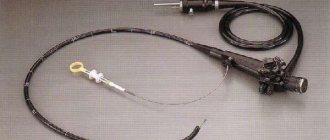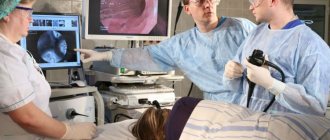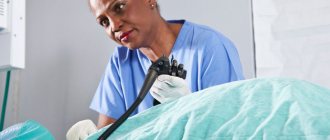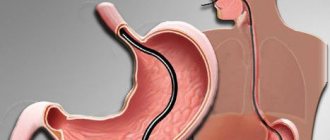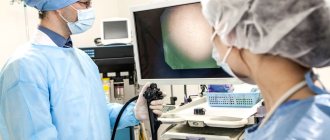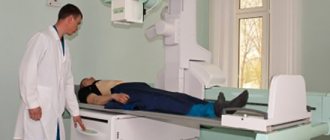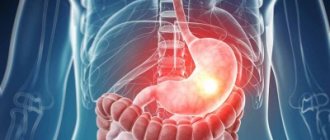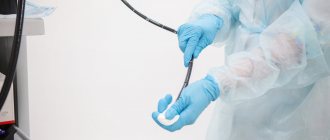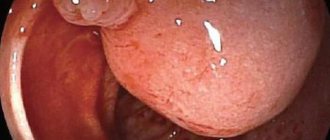- home
- Copy
- Gastroscopy
17.01.2019
FGDS (fibrogastroduodenoscopy) is one of the most informative methods for diagnosing diseases of the stomach and duodenum. It is performed at almost any age, and when examining children, there is a separate subtype of the procedure - pediatric gastroscopy. FGDS can be performed on children only with the help of special equipment.
Almost every gastroenterologist's office is equipped with a pediatric endoscope. Its design features make it possible to conduct an examination even in infants with the most comfort and with the least risk.
At what age is FGDS performed on children?
Diagnostic and therapeutic gastroscopy can be performed on children even in infancy. There are no radical restrictions on the age at which this procedure is performed, but some doctors still take into account the feasibility and safety of the method up to the age of 8 years. In this age period, the patient may be aware of the need for medical procedures and behave adequately when preparing and performing gastroscopy.
Many parents are sure that it is dangerous to do gastroscopy at an early age due to the small size of the baby’s throat. They believe that up to the age of 5 their child is not able to endure such a serious intervention in the body. However, gastroenterologists assure: the procedure is safe, and it cannot harm even a baby, much less a patient of preschool and school age, or a teenager. To reduce risks, gastroscopes suitable for the patient are used:
- for FGDS examination of infants, the smallest diameter tubes are used, the thickness of which does not exceed 8 mm;
- for examination of preschool children, tubes with a diameter of 8-10 mm are used;
- children over 10 years old can use tubes with a diameter of 10-12 mm;
- To examine adolescents over 14 years of age, standard “adult” gastroscopes are used.
Note! In addition to choosing the size of equipment for performing FGDS on a child, various methods of pain relief are also considered. For each age, the doctor selects the safest methods.
Is FGDS performed on infants?
Diagnosis of pathologies of the digestive tract using FGDS in babies in the first year after birth is not contraindicated. Moreover, sometimes it can be used to save an infant’s life, for example, when a foreign object is swallowed or a congenital defect of the esophagus or stomach is suspected. In infancy, FGDS is always done under general anesthesia.
Is pediatric gastroscopy with biopsy performed?
At an early age, it is extremely rare for children to develop diseases that require a biopsy to be taken during gastroscopy. However, if the doctor suspects tumor processes in the larynx, esophagus and stomach, it is impossible to do without taking biological material for microscopy and histology. Among all the methods that make it possible to obtain pieces of the mucous membrane for analysis, gastroscopy for a child is considered the least traumatic. Regardless of the age at which FGD with biopsy is performed, the procedure requires the use of general anesthesia.
Indications for use
The examination can take place on a scheduled or emergency basis. A routine examination is carried out if the child exhibits symptoms of gastrointestinal diseases for a long time.
A planned gastroscopy procedure is prescribed for the following indications:
- sudden weight loss or lack of weight;
- regular spasmodic pain in the abdominal area;
- constant vomiting, regurgitation;
- pathologies of the pancreas and biliary tract.
If symptoms recur regularly, it is necessary to undergo a routine examination.
In emergency cases, gastroscopy is performed for children if there is a suspicion of serious pathology of the digestive organs. The risk of complications after EGD in children is higher than in adults.
FGDS on an emergency basis
Urgent gastroscopy is required for the following pathologies:
- stomach bleeding;
- cauterization of a damaged vessel that is bleeding;
- there is a possibility of a foreign object entering the esophagus;
- burn of the mucous membrane with acid or alkali;
- if there is a suspicion of malformations of the digestive organs.
In this case, the procedure is performed without preparation, often under general anesthesia.
Indications and contraindications for gastroscopy in children
The feasibility of performing FGDS in children is considered by a pediatric gastroenterologist. The reason for the examination may be severe symptoms of pathologies of the stomach and duodenum:
- systematic nausea and vomiting;
- vomiting blood;
- heartburn;
- pain in the stomach and upper abdomen;
- weight loss with proper nutrition;
- delayed physical development;
- difficulty swallowing food;
- feeling of pressure and pain behind the sternum.
The listed symptoms may indicate gastritis, stomach ulcers, congenital anomalies (holes in the esophagus or stomach), as well as tumor processes in the esophagus, stomach and duodenum. Gastroscopy of the stomach is also used when foreign objects enter the digestive tract of children.
Contraindications to an FGDS examination may include diseases that may interfere with a normal examination or pose a risk of bleeding:
- ulceration and chemical burn of the esophagus;
- strictures of the esophageal tube;
- congenital defects of blood vessels in the area of study (esophageal varices or aortic aneurysm);
- severe scoliosis;
- hemophilia and other diseases characterized by decreased blood clotting;
- general infections and severe conditions - organ failure in the stage of decompensation.
If they are present, the doctor selects other diagnostic methods or makes a delay and prescribes a course of treatment to eliminate the identified pathologies.
Endoscopic picture
The mucous membrane of the digestive organs of a small patient should have a light pink tint, a shiny and smooth surface. In addition, the vascular network is clearly visible along the entire length of the esophagus. During an endoscopic examination of infants, it is clear that there are practically no folds in the stomach, and its walls have the same structure in all sections. The jagged border between organs appears smoother and more curved.
During the examination, when air is supplied, the internal epithelium of the organs is easily straightened. Using an endoscope, the doctor can detect areas with pathological abnormalities in the tissues of the gastrointestinal tract. This equipment allows you to identify defects and disorders in all parts of the digestive system.
During diagnosis, you can carry out local treatment (remove polyps) or take a smear for analysis.
How to prepare your child for the procedure
Preparing for a pediatric gastroscopy is somewhat more difficult, especially if the patient is still small and does not realize the importance of what is happening. First of all, it is necessary to ensure that the baby’s stomach is empty at the time of gastroscopy, so preparation for FGDS always includes a short-term refusal of food. The time of the last feeding depends on age:
- Breastfed babies are fed at least 3 hours before the examination, after which you should not give the baby breastfeeding or give him water;
- children from 1 to 3 years old are fed 4-7 hours before the procedure, choosing the lightest possible foods without dyes - natural clarified juices, yogurt without additives, or milk;
- Children over 3 years of age stop feeding 8 hours before the procedure, water is limited 1-2 hours before the start of the examination;
- For schoolchildren and teenagers, the standard rule applies - the last meal is 8 hours before gastroscopy, drinking no later than 2 hours before diagnosis.
In order to mentally prepare a child for gastroscopy of the stomach, it is worth describing to him the essence of the examination and explaining that he will not feel pain. Older children can be shown a video of the FGDS procedure, but if the baby is impressionable, this should not be done.
Note! Children from 5 years of age should be taught to breathe correctly during FGDS. You can start training a few days before the scheduled test date.
Features of the procedure for young children
Until recently, when the examination was carried out without anesthesia, it was difficult to do a gastroscopy. The child developed panic, and it was almost impossible to insert a probe into the gastrointestinal tract.
How to prepare for the procedure
Before probing, children are not given food for at least 8 hours (better - 12, infants - 6 hours). The day before gastroscopy, mineral and alkaline water should be excluded.
On an empty stomach, the study is more informative, and the risk of vomiting is minimized. If the examination is urgent, the stomach is emptied before surgery.
Psychological preparation is no less important. Children over 3 years of age must be set up for examination and the importance of the procedure explained. You can give your child his favorite toy.
It is important to explain to your child how to breathe correctly during gastroscopy if it takes place without anesthesia.
At home, you can practice calm, even breathing through your nose. They do this to avoid psychological trauma so that the baby’s procedure goes without complications.
When visiting a doctor, you must have with you a medical card, results of tests and other examinations (if carried out), a diaper, a towel, and disposable napkins.
To use anesthesia or not
The need for anesthesia before the procedure is discussed with the doctor. The examination can take place under local or general anesthesia.
Currently, before gastroscopy, children under 7 years old are given an injection with sedatives. Infants under 3 months of age are given anesthesia for medical reasons . During the procedure, the child is in a state of sleep and does not resist.
Additionally, atropines are used. These drugs allow you to painlessly insert a probe into the esophagus. Anesthesia can be either general or local depending on the condition.
The age of the child should also be taken into account . Anesthetics allow you to “freeze” the larynx area and suppress the gag reflex.
Features of carrying out under anesthesia and without
While under anesthesia, the baby does not experience fear and does not see the progress of the entire operation. This greatly facilitates the doctor’s work and allows the examination to be carried out quickly and efficiently.
If, due to age or illness, the use of sedatives is impossible, the procedure is performed without them. However, the examination does not always go smoothly. In this case, the child’s psychological mood, the closeness of the parents, and the degree of trust in the doctor are important.
How is an FGDS performed on a child?
When conducting an FGDS in a child, the doctor is guided by standard rules and uses proven techniques that differ only slightly from those used for adult patients. Before gastroscopy, children under 5 years of age are given sedatives, under the influence of which they will remain asleep throughout the procedure.
Important! If there are contraindications to performing FGDS under sedation, the doctor considers the option of performing gastroscopy under anesthesia - for young children this option is used less frequently, since the drugs are more harsh.
For school-age children who can control their behavior, the procedure is performed without anesthesia. Local anesthesia with a solution of lidocaine or ultracaine is used. The drugs eliminate the sensitivity of the root of the tongue and reduce the risk of gagging.
After the anesthesia has taken effect, the doctor inserts a mouthpiece into the patient’s mouth so that during manipulation the gastroscope tube is not compressed by the teeth. After this, a probe is inserted into the oral cavity, which is delicately advanced into the esophagus and further into the stomach. Examination of the digestive tract lasts no longer than 7-10 minutes.
How is gastroscopy performed on children?
Just as in the case of adults, the study of children is carried out in the morning (at 8–10 o’clock).
Before the procedure, the baby is given a small dose of atropine under the skin to calm him down. To eliminate pain and the urge to vomit, local anesthesia is necessary. The solution is sprayed onto the root of the tongue; the product must reach the esophagus. In some cases, general anesthesia is used.
Before the procedure, the gastroscope must be sanitized. After the anesthesia has begun, the doctor places the child on the couch on his left side, making sure that his back is straight. Place a towel under your chin to absorb saliva. Small children are swaddled.
Gastroscopy for a child is performed as follows:
- a mouthpiece and endoscope tube are inserted into a lying baby;
- while the patient is inhaling, the doctor carefully inserts the device into his throat;
- watching the breath, smoothly lowers it, constantly turning it.
- Having reached the bottom of the stomach, it stops moving;
- the mucous membrane is examined;
- The device is slowly removed.
The doctor can see the condition of the esophagus and stomach through the eyepiece or monitor it on the monitor. If necessary, a photograph is taken and attached to the medical history.
All manipulations take no more than 10 minutes. The procedure time increases if a biopsy sample is taken or a foreign body is removed.
After gastroscopy, children remain under observation for several hours, and with anesthesia until they completely recover from it.
It is very important that parents are not in the office. Their presence only distracts young patients.
Recovery and possible complications
After gastroscopy in children, a number of unpleasant symptoms may appear, most of which will disappear without additional action after 2-3 hours, and some will persist for up to a day. If discomfort persists longer, you should inform your gastroenterologist about it.
The most common consequences of FGDS:
- sore throat - occurs due to injury to the mucous membrane by the gastroscope tube, persists for about 5-7 hours, does not require additional action;
- nausea, urge to vomit - occur in children with increased impressionability and sensitivity of the larynx, lasting no longer than 2-3 hours;
- burning sensation in the esophagus - caused by microtraumas of the mucous membrane, disappears after 3-5 hours;
- redness of the eyelids - caused by excessive tension and irritation of the eyes due to the release of tears during the examination, lasts no longer than 2 hours.
To relieve unpleasant symptoms, doctors advise giving your baby a slightly warm drink in small portions. This can be plain water, a decoction of chamomile or plantain.
Symptoms such as profuse vomiting of blood and loss of voice due to damage to the larynx and vocal cords should cause alarm. Such complications occur extremely rarely, however, they require immediate hospitalization of the patient and emergency action.
Stomach hurts after gastroscopy
If after FGDS the baby complains that his stomach hurts, you should not ignore the unpleasant symptoms. You should try to find out where the pain is localized, when and how it manifests itself, and whether there are any other complaints. If the source of discomfort is the stomach, and symptoms appear immediately after the end of gastroscopy, this may be normal. The following situations are exceptions:
- intense cutting pain in the upper abdomen or spreading to the entire abdomen;
- the appearance of bloody or black vomit;
- increased body temperature;
- excessive, atypical sleepiness and lethargy in children under 3 years of age.
To avoid abdominal pain, children should be given the lightest and most gentle nutrition possible after FGDS. You should exclude any sweets, carbonated drinks, snacks and fast food from the menu. Food should be soft, smooth and slightly warm.
Can a child cough after FGDS?
Coughing is the body's natural reaction to irritation of the airways and throat, so it is quite expected that young patients will cough after FGDS. Such consequences are especially typical for children under one year of age: after gastroscopy, salivation may increase, and he may choke on saliva.
Note! A dry or wet cough with clear sputum is considered normal. The release of droplets of blood requires immediate emergency medical attention.
General concepts
The essence of gastroscopy is to assess the condition of the esophagus, stomach, and in some cases the duodenum, based on the results of a step-by-step visual examination of the mucous surface of all of the above structures of the upper gastrointestinal tract (GIT).
The main impetus for the development of endoscopic research methods was the discovery of fiber optics, which has high resolution and allows image transmission when the fiber is bent in any direction. A modern gastroscope is a flexible structure in the form of a movable tube with a diameter of 0.5 to 1.3 cm, the distal end of which can be easily controlled.
Depending on the volume of research and the technology used, there are:
- Fibrogastroscopy (FGS). A diagnostic test that evaluates the condition of the esophagus and stomach cavity.
- Fibroesophagogastroduodenoscopy (FEGDS) or fibrogastroduodenoscopy (FGDS). In this case, in addition to the stomach and esophagus, the duodenum is also examined.
- Video esophagogastroduodenoscopy (VEGDS). A modern version of gastroscopy, which allows, in addition to conducting the study itself, to record the obtained data on removable media (flash drive, DVD).
When carrying out diagnostics, mainly flexible endoscopes are used, which allow inspection even in the blind spots of the gastrointestinal tract. To carry out surgical or medical manipulations, rigid endoscopes are used, which have a fairly wide cavity for introducing various instruments.
Important! When performing gastroscopy in children, it is necessary to use endoscopic equipment taking into account the age of the child and the width of the esophagus. As a rule, the thickness of the gastroscope used to diagnose pathologies of the upper gastrointestinal tract does not exceed 0.6 cm.
The thickness of the fiber gastroscope tube, used for examining children under 6 years of age, is 0.53 cm thick.
Carrying out the procedure
Contrary to popular belief, in children this procedure is much faster and less problematic than in adult patients. The most important thing is to maintain a positive attitude in the baby and give the right psychological attitude. Make sure that on the day of the examination the child comes to the clinic on an empty stomach, and that the last meal was no earlier than 6-8 hours ago. You must have with you:
- Referral to the procedure;
- Towel;
- A sheet;
- Necessary tests;
Gastroscopy for a child can be performed in two ways:
- Under local anesthesia;
- General anesthesia;
The appropriate technique is selected individually for each patient. Based on the age, health status of the baby, the goals of the study and the capabilities of the clinic. The price depends on the scope of the inspection.
First of all, the little patient is premedicated with atropine. The mucous membrane of the throat is then irrigated with a local anesthetic. Gastroscopy of a child is performed in a supine position, on the left side, with legs slightly bent at the knees and a straight back. If intravenous administration of the drug is not required, infants are simply swaddled, without additional fixations. A specific nozzle is placed in the child’s mouth, through which the examination device is inserted.
For children under one year of age, a reduced gastroscope tube is inserted, up to 5-7 mm. Considering that this size is much smaller than a bolus of food, insertion does not cause difficulties, and the chamber freely sinks into the throat at the first swallowing movement. In this case, breathing is not blocked, and in order to avoid gagging, it is important to control inhalations and exhalations. They should be smooth and unhurried.
Features of pediatric gastroscopy
Gastroscopy for children is performed using the same technique as for adults. But a children's gastroscope is very small in size. It is three times thinner than a pediatric esophageal tube. Technologically modern devices make it possible to perform the procedure even for babies who are not yet a year old. Let's look at how gastroscopy is done for children, and whether such a study differs from how it is done in adults.
Gastroscopy for a child under 6 years of age is performed under general anesthesia. Full general anesthesia is rarely used; usually the child is put into a state of semi-asleep. This is done so that he does not worry and does not interfere with the procedure. Older children already understand the meaning of what is happening, and, like adults, they are given local anesthesia. The area of the pharynx and pharynx is treated with a special spray, usually based on lidocaine. This is done to make it easier to swallow and prevent the gag reflex.
After the anesthesia has taken effect, the child is placed on the couch on his left side. In this case, the right leg should be brought to the stomach, and the left should be straightened or slightly bent. Like an adult, the child is given a special mouthpiece, which prevents the mouth from closing and the tube from being damaged by the teeth.
At the end of the endoscope there is a camera and a light source. The doctor carefully inserts the tube, asking the child to swallow. Each time you swallow, the gastroscope penetrates deeper and deeper. Upon reaching a special mark, the doctor begins to examine the gastric mucosa. All data from the camera is displayed on the monitor. The doctor takes pictures and notes. When performing an FGDS, the duodenum is then examined. At the end of the procedure, the probe is carefully removed.
During the examination, the doctor evaluates:
- esophageal mucosa;
- relief of the gastric epithelium;
- condition of the gastric mucosa, presence of erosions and ulcers;
- the presence of polyps and neoplasms.

